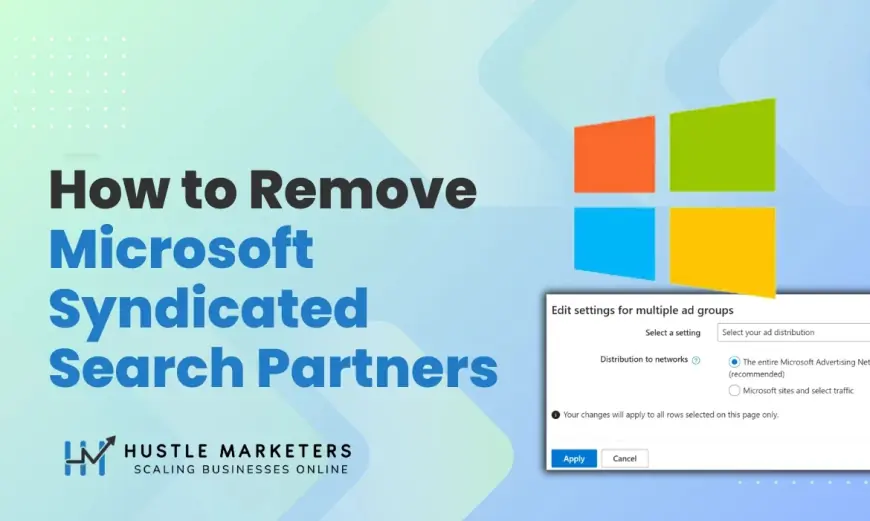How to Remove Microsoft Syndicated Search Partners from Ad Campaigns?

Microsoft’s syndicated search partners are often responsible for irrelevant traffic, poor-quality clicks, and inflated ad costs. While these placements are designed to “extend your reach”, they can quietly erode your budget without delivering conversions. For advertisers serious about performance, it's crucial to understand—and control—exactly where your ads are appearing.
In this guide, we’ll break down everything you need to know about removing Microsoft syndicated search partners from your ad campaigns, including the why, the how, and when to seek expert help.
Table of Contents
-
What Are Microsoft Syndicated Search Partners?
-
The Hidden Cost of Syndicated Traffic
-
How to Identify Low-Quality Traffic Sources
-
How to Remove Microsoft Syndicated Search Partners
-
Pros and Cons of Removing Syndicated Partners
-
When to Consult a PPC or CRO Specialist
-
Final Thoughts
What Are Microsoft Syndicated Search Partners?
Microsoft’s advertising network includes Bing, AOL, Yahoo, and a wide range of syndicated search partners—third-party websites and apps that show Microsoft search results and ads. These partners can include anything from niche search engines to toolbars and browser extensions.
At first glance, it might seem like a smart way to reach more users. But the reality? Many of these platforms don’t deliver high-quality traffic—especially for advertisers focused on conversions, like those in e-commerce PPC management.
The Hidden Cost of Syndicated Traffic
Advertisers often overlook how much budget is silently being eaten up by underperforming sources.
Let’s say you’re a PPC agency managing campaigns for multiple clients. You might notice great volume but subpar performance on key metrics:
-
High bounce rates
-
Low time on site
-
Poor conversion rates
-
Low-quality leads
These issues are often tied to syndicated search partners. Some of these sources use aggressive or misleading tactics to generate ad clicks—making it seem like your campaign is working, when it’s actually wasting budget.
If you’re not auditing publisher performance regularly, your cost-per-conversion can skyrocket without you even realising it.
How to Identify Low-Quality Traffic Sources
Before removing partners entirely, it’s smart to evaluate which sources are hurting performance.
Step 1: Run a Publisher Performance Report
Go to your Microsoft Ads dashboard:
-
Navigate to Reports → Performance
-
Select Website URL (Publisher) as a dimension
-
Filter by conversions, CTR, and bounce rate
This report shows where your ads are being shown—and how each site is performing.
Step 2: Look for Red Flags
Low engagement metrics or zero conversions from high-spend sources? That’s a sign the traffic isn’t aligned with your intent. In some cases, this traffic might even be click fraud, triggered by bots or incentivised clicks.
If you're working with a digital marketing agency, they’ll usually have tools in place to spot and block suspicious activity early.
How to Remove Microsoft Syndicated Search Partners
Microsoft Ads doesn’t offer a simple on/off toggle like Google does, but there are effective workarounds.
Option 1: Limit Ad Distribution to Microsoft Sites Only
The most straightforward solution is to restrict your ad delivery to Microsoft-owned properties.
Here’s how:
-
Go to your campaign’s Settings.
-
Scroll to the Ad Distribution section.
-
Choose “Bing, AOL, and Yahoo search (owned and operated only)”.
-
Save changes.
This immediately excludes all syndicated search partners and keeps your ads limited to the core Microsoft network.
⚠️ Note: This setting may reduce your reach—but your traffic will likely be higher quality.
Option 2: Exclude Specific Sites Manually
If you prefer a more granular approach:
-
Pull the Publisher Website URL report.
-
Identify underperforming or irrelevant domains.
-
Contact Microsoft Ads support and request to block those specific placements.
While this process is manual, it’s worth it for advertisers who want to preserve reach while filtering out low-quality sites.
Pros and Cons of Removing Syndicated Partners
| Pros | Cons |
|---|---|
| Higher conversion rates | Reduced traffic volume |
| Better ad spend efficiency | Potentially slower campaign scaling |
| More control over placements | Time-consuming exclusions if done manually |
| Less risk of click fraud | May require ongoing monitoring |
Ultimately, it comes down to your campaign goals. If your KPIs are centred around leads, sales, or ROI, then filtering out unqualified traffic is non-negotiable.
When to Consult a PPC or CRO Specialist
If this process feels technical or time-consuming, you’re not alone. Managing ad platforms—especially across Google, Microsoft, and Meta—requires constant optimisation and reporting.
That’s why many businesses partner with:
-
A certified Google Ads Specialist to manage and scale campaigns across search platforms
-
A dedicated CRO agency to improve landing page performance and increase conversions
-
A full-service SEO agency for traffic quality and keyword targeting
-
Or a white label marketing agency to support internal teams or serve client accounts
At Hustle Marketers, we help brands take full control of their paid ad performance—ensuring every click has the potential to convert.
Final Thoughts
Microsoft’s syndicated search partners can feel like a hidden tax on your campaigns. While they offer reach, they often sacrifice relevance—and relevance is what drives conversions.
By proactively managing your ad distribution settings, monitoring your publisher reports, and eliminating underperformers, you can drastically improve the efficiency of your Microsoft Ads campaigns.
Still unsure where to start? Our team at Hustle Marketers has helped hundreds of businesses and agencies take control of their ad spend. Whether you’re managing one brand or scaling multiple client accounts, having expert support can make all the difference.
Author: Ishant Sharma
Ishant Sharma is a Google Ads Specialist, Meta Ads Expert, Bing Ads Consultant, and seasoned SEO strategist. With over 10 years of experience helping businesses scale their digital marketing performance, he’s worked with global brands and fast-growing startups alike.
? Connect with Ishant on LinkedIn
What's Your Reaction?
 Like
0
Like
0
 Dislike
0
Dislike
0
 Love
0
Love
0
 Funny
0
Funny
0
 Angry
0
Angry
0
 Sad
0
Sad
0
 Wow
0
Wow
0

















































